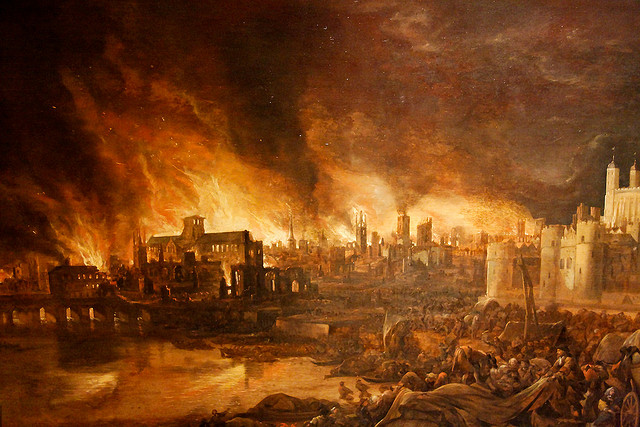On this day, 2 September, 349 years ago, a small fire started in the oven of a bakery on Pudding Lane, London. The baker, along with his family and servant, clambered out of a bedroom window as the flames ripped through the building. Before long the whole street was on fire, and shortly after, the whole city. This was, of course, the Great Fire of London, one of the most dramatic events in British history.
By 5 September 1666, three days on from the sparking of those first embers, 70,000 people were left homeless and London was reduced to rubble. Even St Paul’s Cathedral – one of the largest and grandest buildings in Europe – was destroyed. Faced with such unprecedented destruction, the people of London were desperate to find someone – or something – to blame.
As such, one of the biggest conspiracy theories in London’s history was born.

The Conspiracy
History tells us that when disaster strikes, those affected need somebody to point the finger at. In Protestant England, the scapegoat seemed obvious: the Catholics.
As soon as the fire ended, Dutch, Irish, French and Spanish immigrants were being murdered in the streets. Rumours even started to spread that King Charles II had started the fire in revenge for London’s support of Parliament during the English Civil War.
In October 1666, Londoners believed they’d found their arsonist – a French watchmaker called Robert Hubert. In a forced confession, the young Hubert confessed to firebombing the bakery on Pudding Lane. Although few of the jury at his trial believed him to be guilty, he was sentenced to death. Interestingly, Hubert was reportedly preceded to the scaffolding at Tyburn by an effigy of the Pope that was filled with live cats and burned.
Hubert’s guilt was even inscribed in stone for 200 years, with the commemorative monument next to Pudding Lane declaring that: “ The most dreadful Burning of this City; begun and carried on by the treachery and malice of the Popish faction… Popish frenzy which wrought such horrors, is not yet quenched…”
However, the execution of Hubert did little to quell the anti-papist conspiracy theories surrounding the Great Fire. These fears were reignited whenever a wave of anti-Catholic feeling hit the country, including during the ‘Popish Plot’ of the late 17th century.
In London, in the late 1670s and 1680s, these conspiracy theories even fuelled ‘Pope-burning processions’, where Londoners dressed as cardinals and monks, burned effigies of the Pope and enjoyed music and fireworks.
It was not until years later that the conspiracy theory was finally laid to rest.
The Reality
The true cause of the Great Fire is neither dramatic nor surprising. In reality, a single spark caused the fire that destroyed an entire city. As a result of an exceptionally hot summer, London’s wooden buildings were dry and flammable.
This meant that when a fire took hold in Thomas Farriner’s bakery in Pudding Lane, it didn’t take much for it to spread through the narrow streets.
But what caused the fire? While excavating the remains of a burned-out shop on Pudding Lane in 1979, archaeologists discovered the charred remnants of 20 barrels of highly flammable (pitch) tar in the cellar. This would have been enough to turn a small blaze spread from a spark from a nearby bakery’s oven into the raging fire that would destroy London.
